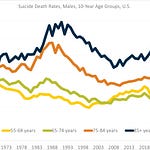In which I use some “mysterious” deaths in the Dominican Republic, gun deaths, and drug overdose deaths to talk about two core cognitive biases: confirmation bias and availability bias (or heuristic). I also use non-mortality examples from an article I wrote in 2010.
Episode Links
Battling Cognitive Bias
April 2010: “Battling Cognitive Bias”, The Stepping Stone, Society of Actuaries
Time and again, one hears stories where a commonly seen effect is ignored by scientists for years as “noise”, “coincidence” or “irrelevant”. Only later, other people without these built-in preconceptions can make real breakthroughs.
For example, in the article, “Accept Defeat: The Neuroscience of Screwing Up” author Jonah Lehrer recounts the story of Arno Penzias and Robert Wilson, who had been trying to make a detailed map of the Milky Way. They had built a very sensitive radio telescope, and in tuning it up, discovered some “noise” wherever they pointed their telescope. Their original assumption was that there was something wrong with their setup or their equipment, and thus spent a long time troubleshooting something that wasn’t actually trouble.
But that background radiation never went away.
For a year they simply ignored that “noise” to make the measurements they had set out to make. Luckily, they did decide to really look into it, and considered the “noise” to be a very real signal—this “noise” was evidence of the Big Bang, and Penzias and Wilson later shared the Nobel Prize in Physics because of this discovery. How often has this happened to you—you entirely miss a solution to a problem, because you have already decided on an answer and ignore all signals outside of your expectation? Being aware of the biases built into our brains can help us combat them. One can’t fix what one doesn’t know is broken. Given there are so many biases, I will concentrate on two, and possible remedies for them.
Wikipedia: Availability Heuristic
The availability heuristic, also known as availability bias, is a mental shortcut that relies on immediate examples that come to a given person's mind when evaluating a specific topic, concept, method, or decision. This heuristic, operating on the notion that, if something can be recalled, it must be important, or at least more important than alternative solutions not as readily recalled,[1] is inherently biased toward recently acquired information.[2][3]
The mental availability of an action's consequences is positively related to those consequences' perceived magnitude. In other words, the easier it is to recall the consequences of something, the greater those consequences are often perceived to be. Most notably, people often rely on the content of their recall if its implications are not called into question by the difficulty they have in recalling it.[4]
“Suspicious” Dominican Republic Deaths
From June-July 2019:
Mortality with Meep: How Many Deaths Before it's No Longer a Coincidence?
Obviously, a certain number of people are going to die while on vacation each year, and some may have trouble after drinking a bit much.
So, what would be the number of people dying before it’s justified to think it’s more than just coincidence?
This story says 9 deaths: Timeline of deaths – goes back approximately one year.
How many Americans visit the Dominican Republic each year?
According to Wikipedia, about 2 million Americans per year, but those people probably stay about a week each. I need to turn this number into people-years, aka, I divide that 2 million by 52 weeks (assuming 1 person stays about one week) in order to get the right number for “exposures”, that’s about equivalent to 38,500 people each staying one year to get exposure units.
So 9 people out of 38,500 people-years is an annualized q_x of 0.023%.
….
Okay, statistically, how many “excess deaths” would it take before we can say it’s not a coincidence?
….
So, if 225 Americans died in the DR in one year, I might start to get suspicious.
That’s about 225-193 = 32 “excess” deaths to be an anomaly.
Of course, this is all dependent on my exposures and base estimate for mortality. It can be due to age mix I should expect more (or fewer) deaths.
Mortality with Meep: Dominican Republic and Raw Death Rates
The problem for the Dominican Republic is purely public relations right now. Comparing numbers like death rates is not going to convince anybody who is deciding on a location to vacation at.
There’s this bit:
But nobody really has a bias for thinking that somebody is going around murdering Americans in the Dominican Republic.
Let’s think of something that’s far more endemic: antivaxxers. They will not be convinced by numbers. It’s purely emotional reaction at this point.
Truth is one of my highest values, and I have a bias of digging into my assumptions. I am particularly aware of cognitive biases.
But that’s not how most people are (and I wouldn’t even argue that’s how most people should be. I don’t dig into every damn thing myself because it gets exhausting. Somebody needs to make the donuts and not spend time questioning everything.)
So they need to find some good emergency communications people, because this ain’t cutting it.
I agree that the numbers themselves don’t show a problem, but the problem is no longer about the numbers.
I have no recommendation on this score, because this really isn’t something I have expertise about. I can only tell the “you probably won’t die” is not a good message to convey. “Most people survive!” is not any better.
DO BETTER.
Mortality with Meep: Even More Dominican Republic Deaths
I think getting the FBI to help may be useful, but, unfortunately, you will get people who say “they’re covering it up!” even if those autopsies/toxicology reports come up with nothing untoward.
Every so often one gets a spate of these media panics (such as the shark attack summer of 2001), because the beast must be fed. Sometimes these stories are placed… such as when somebody has a big lawsuit, and they’re trying to get judgment by press.
But dear lord, people, stop arguing the statistics. Get the autopsies/toxicology reports done and disclose the info…. though the relatives may not want the info disclosed. Such as if drug use was involved in some of these cases.
In any case, I’ll keep up with this, because death rates are my jam. And so far, I agree with the DR officials that the specific numbers are not suspicious. But we shall see.
Deaths in the Dominican Republic: How Many are We Up To Now?
Here is my problem with these — it’s the count. A lot more than 11 or 12 American tourists had to have died in the Dominican Republic over the past year (my prior figuring that likely a few hundred die every year).
I already flagged a few of the ones that were not mysterious at all. This one claims 12 “mysterious” deaths, and others had claimed 11. Who the heck is keeping this list? Can we have a central clearinghouse indicating which deaths are mysterious and which are not?
I believe the State Dept., etc., when they say that there’s not an uptick in deaths of tourists in the DR. It’s just that it’s easy to find a “pattern” when this stuff happens all the time. It’s like any media-fueled “trend” (shark attack!). You just decide to publicize something that happens often enough that you’ll get a report at least once a week. So you can keep feeding the media coverage!
Some U.S. Mortality Nuggets
So I appear on a recent BBC 4 audio podcast: I thought you might be interested in posts/graphs of things I was referring to in my snippets. Drug Overdoses I have several posts on drug OD deaths: Nov 2022: Movember 2022: Men and Drug Overdoses (and Giving Tuesday!)















Share this post